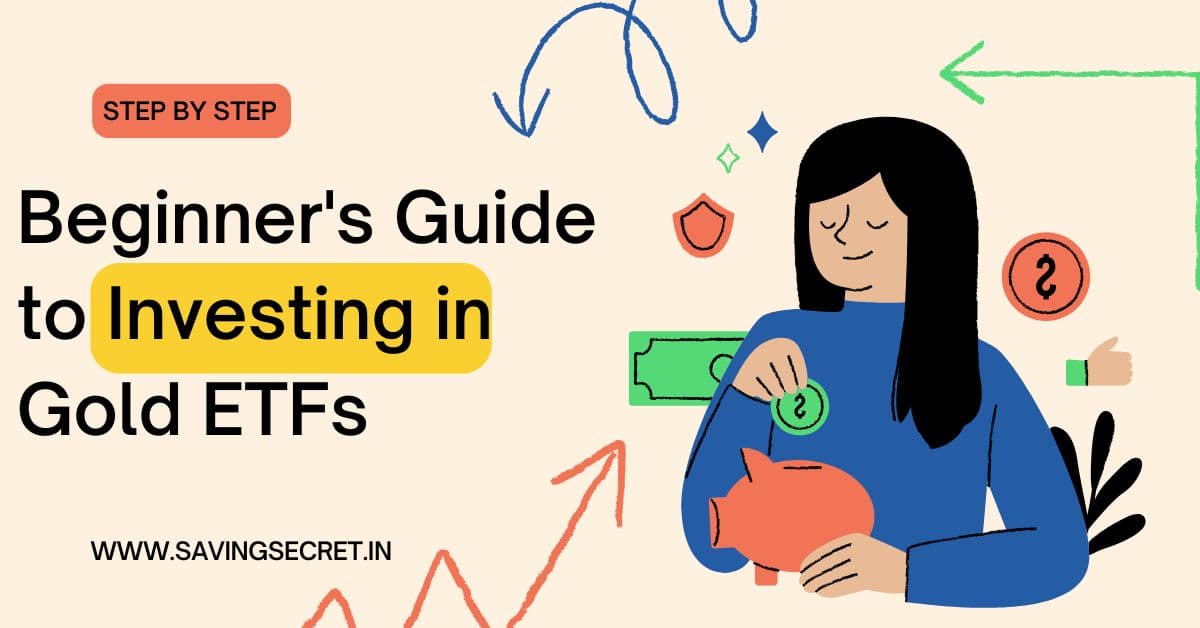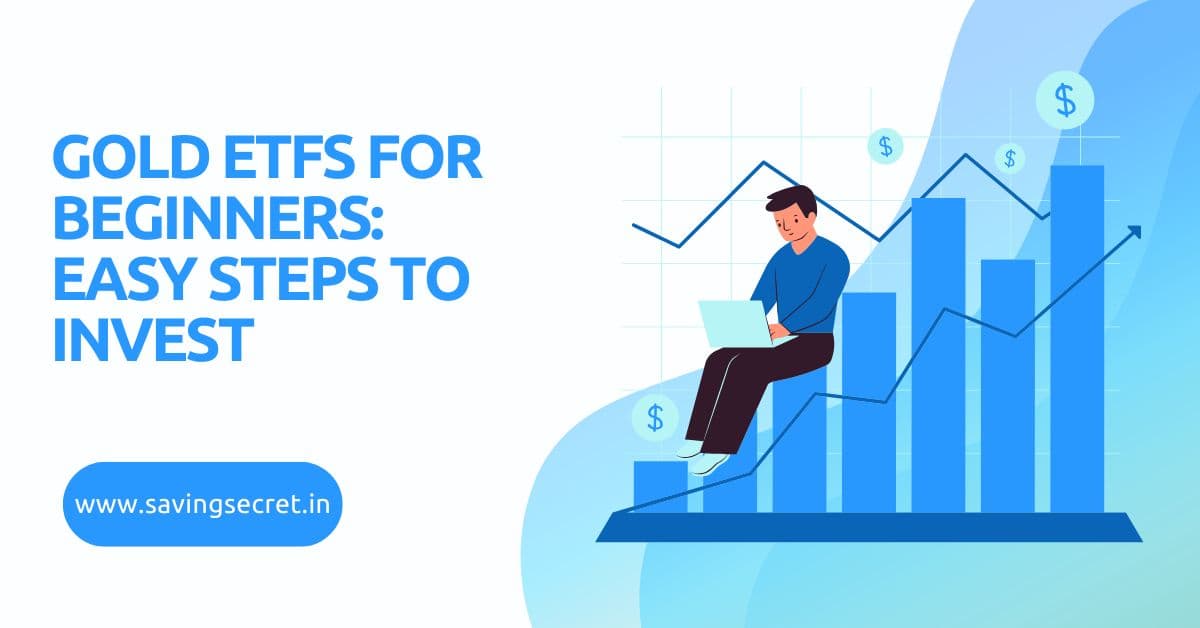Gold ETFs for Beginners: In India, gold has a timeless appeal that is ingrained in both culture and custom. Gold is a sign of wealth and stability, from sparkling jewellery worn by newlyweds to gold bars hidden away as family treasures. The conventional methods of acquiring gold, such as purchasing coins, bars, or jewellery, are becoming more costly and time-consuming in 2024 as the price of gold soars over ₹70,000 per 10 gram. Gold Exchange-Traded Funds (ETFs) provide a contemporary, useful option for novice Indian investors who want to invest without going over budget.
Gold ETFs may seem complicated to novice investors, but they’re actually rather easy. They let you own gold digitally without having to deal with expensive storage. This book will explain Gold ETFs for beginners, regardless matter whether you’re a senior in Chennai looking for stability, a young professional in Bengaluru saving for the future, or a housewife in Delhi making plans for a child’s future. We will define them, discuss why they are appropriate for Indian investors, and offer simple, detailed advice on how to begin investing in 2025. Let’s seize this fantastic chance!
What Are ETFs for Gold?
Gold exchange-traded funds (ETFs) are investment vehicles that mimic the price of actual gold and are traded on stock exchanges such as the National Stock Exchange (NSE) and the Bombay Stock Exchange (BSE). Typically, one gram of gold is represented by each unit of a Gold ETF, which is backed by 99.5% pure gold that is kept in safe vaults by custodians such as banks.

How They Operate: You purchase ETF units from a stockbroker, and the Multi Commodity Exchange, or MCX, tracks domestic gold prices, which determine how much they are worth.
Important attributes:
- Units are kept in a Demat account; there is no actual physical possession.
- Transparent pricing that is based on current gold prices.
- Start with as little as ₹500 to ₹1,000 for a low entrance fee.
For instance, a unit of the Nippon India Gold ETF may trade for ₹70 if gold is worth ₹7,000 per gram, allowing you to invest ₹5,000 for 71 units.
Gold ETFs make investing easier for novices in India by eliminating the hassles associated with actual gold ownership.
Why Gold ETFs Are the Best Option for Novices in India
Although India has an unrivalled passion for gold—more than 800 tonnes were imported in 2023, according to the World Gold Council—traditional approaches have limitations. The following explains why Gold ETFs are ideal for novice Indian investors:
- Affordability: 10 gram of physical gold cost at least ₹70,000, plus 3% GST and 10–20% jewellery-making fees. Gold ETFs, which are perfect for small budgets, allow you to start with ₹500.
- Liquidity: Unlike jewellery, which entails value loss and jeweller haggling, ETF units may be sold immediately during market hours (9:15 AM-3:30 PM IST).
- Safety: Since gold is properly housed, there is no chance of theft or storage costs, which is a comfort for Indians living in cities with limited space.
- Tax Efficiency: Gains over ₹1 lakh are subject to 12.5% taxation (LTCG, 2025 rate) if held for more than a year; this rate is sometimes lower than the slab rates on actual gold transactions.
- Cultural Relevance: Gold ETFs are ideal for protecting against inflation or saving for festivals since they fulfil India’s gold fixation without requiring any physical labour.
With an average yearly increase in gold prices of 15% from 2020 to 2024, gold exchange-traded funds (ETFs) provide novices with a wise option to capitalise on this developing trend.
The Differences Between Physical Gold and Other Options and Gold ETFs
Let’s examine how Gold ETFs differ from actual gold and other options, such as Sovereign Gold Bonds (SGBs), to see why they are unique:
Physical gold, gold exchange-traded funds (ETFs), and sovereign gold bonds (SGBs) are the three options available to investors in gold; each has its own benefits and drawbacks.
Physical gold is a tangible item that may be purchased as jewellery, coins, or bars, but it has greater costs, such as GST, manufacturing fees, and storage costs. Since selling necessitates going to a jeweller or buyer, the minimum investment is somewhat high—starting at about ₹70,000 for 10 grams—and liquidity is reduced. Furthermore, storage may be expensive, with annual locker rates ranging from ₹1,000 to ₹3,000.
Exchange-traded funds, or gold ETFs, provide investors with a digital substitute for real gold by enabling them to trade gold units on the stock exchange. These funds are an economical choice because of their low expenditure ratio, which is between 0.5 and 1%. Because units may be purchased or sold on stock markets instantaneously, investors can start with as little as ₹500 to ₹1,000, and liquidity is strong. Since ETFs are kept in custodian vaults at no additional expense, storage is hassle-free.
Government-backed securities known as Sovereign Gold Bonds (SGBs) offer the added advantage of 2.5% yearly return on the investment. SGBs are very cost-effective since they don’t have an expense ratio as actual gold or ETFs do. Although there are alternatives for an early exit after five years, the minimum investment is ₹7,000 for one gramme, and the lock-in period of eight years reduces liquidity. SGBs are a safe long-term investment because storage issues are removed due to their digital format.
Different investor demands are met by each option: SGBs provide long-term returns with interest income, ETFs provide liquidity, and real gold serves tradition.
Gold ETFs are a good option for beginners since they are less expensive than actual gold, more adaptable than SGBs, and easy to use.
Beginner’s Guide to Investing in Gold ETFs
Are you prepared to purchase Gold ETFs? Take the following six easy steps, which are designed for novices in India:

Step 1: Create a Trading and Demat Account
Why It’s Necessary: Like stocks, gold exchange-traded funds (ETFs) need a trading account to purchase or sell and a Demat account to keep units.
How to Complete It:
- Select a broker from ICICI Direct, Upstox, Angel One, or Zerodha (₹0 broking).
- Full KYC: It takes one to two days to submit your bank information, Aadhaar, and PAN online.
- Costs include an initial cost of ₹0-₹500 and yearly maintenance of ₹200-₹400.
Example: Sunil, a student from Pune, linked his HDFC savings account in a day and established a Zerodha Demat for ₹200.
Advice: To cut costs, especially if you’re starting with little sums, choose bargain brokers.
Step 2: Look at India’s Best Gold ETFs
Common Choices:
- The Nippon India ETF Gold BeES: Has a large trading volume, a 0.79% expense ratio, and tracks MCX gold prices.
- HDFC Gold ETF: a liquid, dependable brand with a cost ratio of about 0.6%.
- SBI Gold ETF: Supported by SBI, this beginner-friendly fund has an expense ratio of about 0.65%.
- Axis Gold ETF: Increasingly well-liked, affordable fees.
How to Make a Decision: Examine past performance (5–10% yearly returns), liquidity (greater guarantees simple trades), and expense ratios (lower lowers expenses).
Context: Gold BeES units closely resemble current gold prices, trading at about ₹70 per gram.
Tip: To examine ETF data and reviews, use moneycontrol.com or bseindia.com.
Step 3: Establish Your Goal and Budget
- How to Complete It: Choose your monthly investment amount and purpose, such as inflation hedging, wedding savings, or an emergency fund.
- Illustration: Zero-based budgeting is used by Priya, a teacher in Mumbai who makes ₹40,000: ₹15,000 for rent, ₹10,000 for necessities, ₹5,000 for savings, ₹2,000 for Gold ETF, and ₹8,000 for miscellaneous. She wants to raise 50,000 for a future family gathering.
- Budget Options: ₹5,000 buys more than 70 units, or ₹1,000 buys 14–15 units at ₹70 each month.
Advice: To gain confidence, start modest; for novices, ₹500 to ₹1,000 is sufficient.
Step 4: Order Your Very First Gold ETF
How to Complete It:
- Open your trading app (such as Upstox or Kite by Zerodha).
- Look for the ETF (such as “SBIGETS” or “GOLD BEES”).
- Click “Purchase,” type in the amount (20 pieces at ₹70 = ₹1,400), and then click “Confirm.”
Example: During a price decline in April 2025, Ravi in Bangalore paid ₹3,500 for 50 units of HDFC Gold ETF.
Time: To optimise value, trade between 9:15 AM and 3:30 PM IST; keep an eye out for declines.
Advice: To prevent overpaying during volatile times, use limit orders (set your price).
Step 5: Keep an eye on and grow your investment
- How to Complete It: Use applications (like the NSE app or MCX updates) to check gold prices every week, and add units on a monthly basis as part of a Systematic Investment Plan (SIP).
- Setting: ₹5,000 invested in gold increased to ₹5,600 in a year, a 12% increase in 2024. Gains are compounded by adding ₹1,000 each month.
- Example of Growth: At ₹70 (₹3,500), start with 50 units. It’s ₹4,000 after a year at ₹80, which is a ₹500 profit.
Advice: To increase returns over time, reinvest minor earnings or dividends, if any are given.
Step 6: Make a Profit by Selling Strategically
How to Complete It: When prices reach their high or you reach your target (for example, ₹50,000 for a wedding), you can sell units using your trading account.
Tax Regulations (2025):
- 20% STCG for short-term (less than a year).
- Long-Term (>1 year): profits over ₹1 lakh are subject to 12.5% LTCG.
Example: After 18 months, Meena sold 100 units she had purchased for ₹65 (₹6,500) for ₹80 (₹8,000), paying ₹187 in taxes on ₹1,500 in profit.
Advice: Sell before holidays when demand is high, such as Diwali or Akshaya Tritiya.
Real-World Example: A Beginner’s Achievement with Gold ETFs
Introducing Aditi, a 30-year-old accountant from Hyderabad who makes ₹50,000 a month. For her sister’s wedding in 2026, she wished to invest in gold without purchasing any jewellery. Her path is as follows:
- Step 1: For ₹400, I opened an Angel One Demat.
- Step 2: Select the SBI Gold ETF (cost ratio of 0.65%).
- Step 3: Created a monthly budget of ₹2,000 using ZBB, which includes ₹20,000 for rent, ₹15,000 for necessities, ₹5,000 for savings, ₹2,000 for ETF, and ₹8,000 for miscellaneous.
- Step 4: In January 2025, I purchased 28 units for ₹71 (₹1,988).
- Step 5: By December, 336 units had been added, with 28 units added each month.
- Step 6: In 2026, it was sold for ₹85 (₹28,560), generating ₹4,704 in profit after ₹588 in taxes.
In just 18 months, Aditi transformed ₹24,000 into ₹28,560, a 19% return, demonstrating that Gold ETFs are suitable for novices.
Gold ETF Benefits for Beginner Indian Investors

- Low Price: No GST or manufacturing fees—save 10–20% compared to jewellery.
- Inflation Protection: According to the RBI’s 2025 projection, gold outperforms India’s 4-6% inflation rate.
- Usability: No jeweller visits; you buy or sell using your phone.
- Diversification: Helps novices balance risky stock investments.
Problems and Fixes
- Problem: Price volatility, such as drops of 5–10%, is a challenge.
- Solution: Don’t panic-sell; instead, invest monthly to average costs.
- Problem: Broking fees for small transactions provide a challenge.
- Solution: Make use of Zerodha and other zero-brokerage services.
- Problem: The physical attractiveness of gold is lacking.
- Solution: The answer is to concentrate on profits; ETFs are for wealth, not decoration.
Apps for Beginners: Groww (learning), ET Money (tracking), and Zerodha Kite (trading)
- Websites: mcxindia.com (price updates) and nseindia.com.
- Resources: YouTube (e.g., Pranjal Kamra), RBI’s investor education page.
- Guides: The Significance of Gold ETFs for beginners in India
Why Gold ETFs Are Important for Beginners in India
The expanding middle class and young people in India may now invest in gold thanks to gold exchange-traded funds (ETFs). Given the escalating prices of actual gold (₹7,000+ per gramme) and the ₹1,000–₹3,000 annual storage fees, exchange-traded funds (ETFs) provide a safe and affordable substitute. They are a low-risk method for novices to accumulate cash for long-term objectives in 2025, celebrations, or crises.
Advice for Investing in Gold ETF Success
- Begin Small: Use ₹500 to ₹1,000 to test in order to build confidence.
- Have patience: For average returns of 8–12%, hold for 1–3 years.
- Monitor Trends: Keep up with gold news (such as US dollar exchange rates and holiday demand).
- Don’t overspend: Keep your portfolio at no more than 5–10%.
- Find Out More: Watch instructional videos or read the NSE’s ETF handbook.
Conclusion, begin your gold ETF adventure right now
Beginner-friendly gold exchange-traded funds (ETFs) offer you access to India’s rich history without the hassle of actual ownership. To increase your wealth, open a Demat, choose a reliable ETF, such as Nippon Gold BeES, set up a sensible budget, and make frequent investments. To see them sparkle by 2025, start with ₹1,000 now and purchase 14 units. Gold ETFs enable you to invest wisely, safely, and profitably in a country where gold is king!
Fixed Deposits vs Mutual Funds: Your Guide to Smart Investment Choices!
How to Start SIP with 500 Rupees: A Beginner’s Guide for Indians
